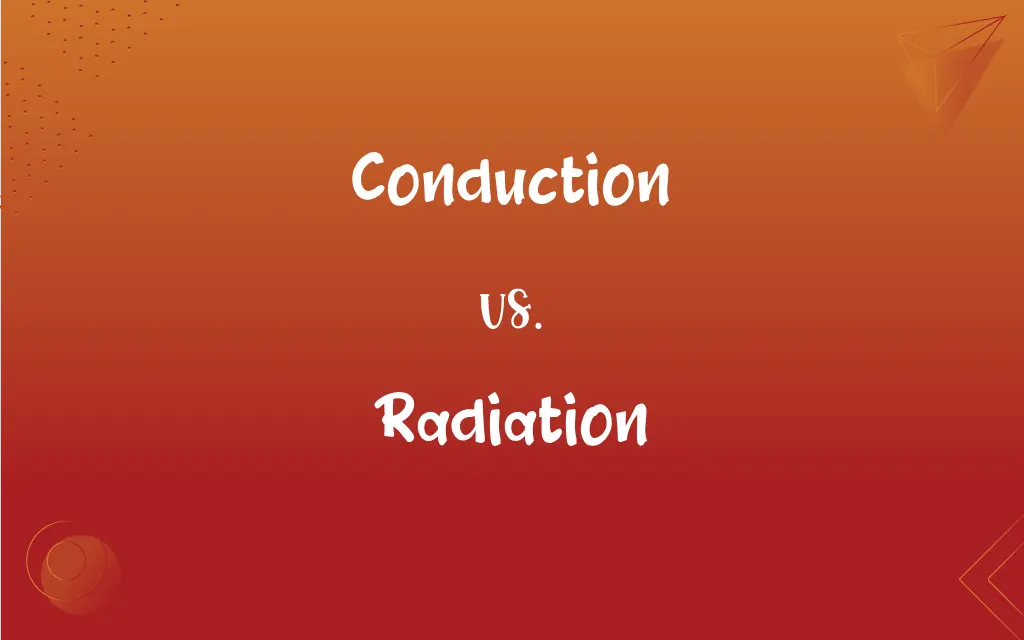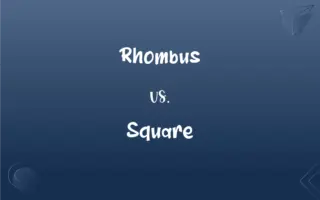Conduction vs. Radiation: What's the Difference?
Edited by Janet White || By Harlon Moss || Updated on October 26, 2023
Conduction is heat transfer through direct contact, while radiation transfers heat via electromagnetic waves without needing a medium.

Key Differences
Conduction and radiation, both mechanisms of heat transfer, operate fundamentally differently. Conduction pertains to the transfer of heat through direct contact between particles, often witnessed in solids. Conversely, radiation involves the transfer of heat using electromagnetic waves, not requiring any medium, and can occur in a vacuum like space.
When you touch a metal spoon left in a hot drink, the heat felt is due to conduction. The spoon's particles, upon gaining heat, begin to vibrate more rapidly, transferring their energy to neighboring particles. This sequence continues throughout the material, resulting in the phenomenon known as conduction. On the other hand, when you feel warmth from the sun on a cold day, you are experiencing radiation. The sun's heat, despite the vast, cold vacuum of space between it and Earth, reaches you through radiant energy.
The efficiency of conduction varies with materials. Metals, for instance, are excellent conductors because of their free electrons aiding rapid heat transfer. In contrast, radiation doesn't rely on material properties for its transfer. Instead, its efficacy is based on the color and texture of surfaces, with darker and rougher surfaces typically absorbing and emitting radiation more efficiently.
While both conduction and radiation play crucial roles in everyday experiences, their governing principles are distinct. Conduction's necessity for direct contact makes it prominent in solid objects, ensuring heat is spread uniformly. Radiation, however, is omnipresent, influencing climates, warming our planet, and even allowing remote controls to function.
Comparison Chart
Mechanism
Transfer through direct contact
Transfer via electromagnetic waves
ADVERTISEMENT
Requires Medium
Yes
No (can occur in a vacuum)
Example Setting
Solids
Space
Dependency
Material properties (e.g., metals are good conductors)
Surface color and texture (darker surfaces radiate better)
Common Experience
Feeling heat from a hot pan handle
Feeling warmth from the sun
Conduction and Radiation Definitions
Conduction
Conduction involves direct interaction of molecules.
Metals transfer heat by conduction efficiently.
ADVERTISEMENT
Radiation
Radiation is influenced by surface characteristics.
Darker clothes absorb radiation more, making you feel warmer.
Conduction
Conduction is predominant in solids.
The ice melted quickly due to the conduction from the warm table.
Radiation
Radiation doesn't require a medium for transfer.
Space, a vacuum, still allows the radiation of heat from stars.
Conduction
Conduction depends on the material's properties.
Wood, being a poor conductor, doesn't allow conduction like metals.
Radiation
All objects emit radiation based on their temperature.
Infrared cameras detect radiation from human bodies.
Conduction
Conduction refers to heat transfer via particle contact.
The skillet's handle got hot through conduction.
Radiation
Radiation transfers energy through electromagnetic waves.
The Earth receives heat from the sun primarily via radiation.
Conduction
Through conduction, energy moves without actual particle movement.
The entire rod warmed up due to conduction from one end.
Radiation
Radiation encompasses a range of electromagnetic waves.
Microwaves use a specific radiation type to heat food.
Conduction
The transmission or conveying of something through a medium or passage, especially the transmission of electric charge or heat through a conducting medium without perceptible motion of the medium itself.
Radiation
The act or process of radiating
The radiation of heat and light from a fire.
FAQs
What are good conductors of heat?
Metals like copper and aluminum are good conductors of heat.
What are insulators?
Insulators, like rubber and glass, are materials that resist the flow of heat or electricity.
What is conduction?
Conduction is the transfer of heat or electricity through a substance, usually a solid, without any movement of the material itself.
How does conduction occur?
Conduction occurs when particles in a material vibrate and transfer energy to neighboring particles.
Can conduction occur in a vacuum?
No, conduction cannot occur in a vacuum as there are no particles to transfer the energy.
Does temperature affect conduction?
Yes, higher temperatures generally increase the rate of conduction.
Does conduction require a medium?
Yes, conduction requires a physical medium like a solid, liquid, or gas.
Can conduction be prevented?
Conduction can be minimized using insulators.
What are examples of radiation?
Light from the sun, heat from a fire, and X-rays are examples of radiation.
What are good emitters of radiation?
Dark, matte surfaces are typically good emitters of radiation.
Is conduction important in everyday life?
Yes, it's crucial in cooking, home insulation, and electrical wiring.
Can radiation occur in a vacuum?
Yes, radiation can travel through a vacuum, unlike conduction.
What is thermal radiation?
Thermal radiation is heat transfer in the form of infrared waves.
Is radiation harmful?
It depends on the type and intensity. Ultraviolet radiation can cause sunburn, while high levels of nuclear radiation can be lethal.
Can radiation be blocked?
Yes, materials like lead can block certain types of radiation.
How does radiation differ from conduction?
Radiation doesn't require a medium, while conduction does.
Does the distance affect radiation?
Yes, the intensity of radiation decreases with distance.
How is radiation used in medicine?
Radiation is used in medical imaging and cancer treatment.
Is conduction the main form of heat transfer in solids?
Yes, conduction is typically the primary form of heat transfer in solids.
What is radiation?
Radiation is the emission or transmission of energy in the form of waves or particles through space or a material medium.
About Author
Written by
Harlon MossHarlon is a seasoned quality moderator and accomplished content writer for Difference Wiki. An alumnus of the prestigious University of California, he earned his degree in Computer Science. Leveraging his academic background, Harlon brings a meticulous and informed perspective to his work, ensuring content accuracy and excellence.
Edited by
Janet WhiteJanet White has been an esteemed writer and blogger for Difference Wiki. Holding a Master's degree in Science and Medical Journalism from the prestigious Boston University, she has consistently demonstrated her expertise and passion for her field. When she's not immersed in her work, Janet relishes her time exercising, delving into a good book, and cherishing moments with friends and family.































































